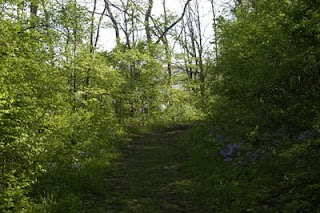No, it is not an expletive. It's a term for the amount of LIFE that is being multiplied in the prairie, pond and woods here at Prairie Pond Woods! After taking a walk on the Refresher Course this afternoon, I was struck by the increase of certain plants, and the number of native trees and wildflowers that actually survived the winter after being transplanted last fall.
Most of the time, as you may have gathered from previous rants, I bemoan the fecundity of invasive species I do battle with every season. But today I was joyful and grateful...and didn't give much attention at all to the crown vetch and honeysuckle popping up and winding over things. No, today I noticed with childlike glee a new patch of Bellwort in the woods, and how far several colonies of Mayapples are spreading. Also this year I counted 12 Jack-in-the-pulpits along the spring creek, about 4 times as many as the first year I went looking.
One of the questions people often ask me when they come for a retreat is, "What are all those little orange flags?" Because I can never remember what I plant from year to year, I have to mark them.
As I strolled along the creek bed, which is mostly dry due to the lack of spring rains, I saw both transplanted flagged Bluebells and Jacob's ladder blooming away! The flags I thought might be Redbud trees I'd already decided to just pluck up and take back, but lo and behold, there they were! Four out of seven made it...OK, so they were only about 8 inches tall and had most of their tops chewed off by browsing deer, but they actually leafed out! Fecundity!
Recently while standing by the edge looking for new shoots of aquatic plants, we saw something moving toward us, looking quite curious. I grabbed my camera and kept taking shots as it crept closer and closer. Finally we saw that it was a bulllfrog in metamorphosis between tadpole and adult. Today, a male Wood Duck also walked at the pond's edge. Then around dusk three of them flew over the house, sending their high-pitched calls into the sky. Fecundity!











